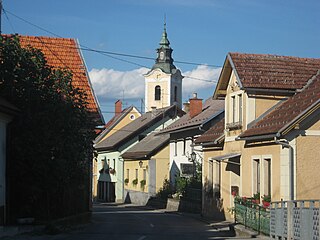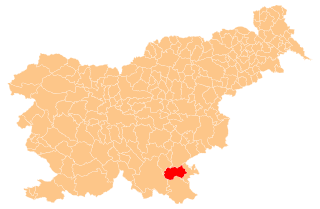
Semič is a settlement in southeastern Slovenia. It is the administrative centre of the Municipality of Semič.

Blatnik pri Črmošnjicah is a small settlement in the Municipality of Semič in Slovenia. It was inhabited by Gottschee Germans that were mostly expelled in 1941 during the Second World War. The area is part of the historical region of Lower Carniola. The municipality is now included in the Southeast Slovenia Statistical Region.

Štrekljevec is a village in the Municipality of Semič in Slovenia. The area is part of the historical region of Lower Carniola. The municipality is now included in the Southeast Slovenia Statistical Region.

Brezje pri Rožnem Dolu is a small settlement in the Municipality of Semič in Slovenia. The municipality is included in the Southeast Slovenia Statistical Region. The entire area is part of the historical region of Lower Carniola.

Brezje pri Vinjem Vrhu is a settlement in the hills south of Semič in southeastern Slovenia. The area is part of the historical region of Lower Carniola. The Municipality of Semič is now included in the Southeast Slovenia Statistical Region.

Brstovec is settlement in the Municipality of Semič in Slovenia. It lies south of Semič in the historical region of Lower Carniola. The municipality is now included in the Southeast Slovenia Statistical Region.

Črešnjevec pri Semiču is a small village east of Semič in southeastern Slovenia. The Municipality of Semič is part of the historical region of Lower Carniola. The municipality is now included in the Southeast Slovenia Statistical Region.

Črmošnjice is a village in the Municipality of Semič in Slovenia. It lies on the eastern edge of the Gottschee region that used to be inhabited by Gottschee Germans expelled in 1941 during the Second World War. The area is part of the historical region of Lower Carniola. The municipality is now included in the Southeast Slovenia Statistical Region.

Gornje Laze is a small settlement in the Municipality of Semič in southeastern Slovenia. The municipality is included in the Southeast Slovenia Statistical Region. The area is part of the historical region of Lower Carniola.

Hrib pri Rožnem Dolu is a small settlement in the hills west of Rožni Dol in the Municipality of Semič in Slovenia. The area is part of the historical region of Lower Carniola. The municipality is now included in the Southeast Slovenia Statistical Region.

Komarna Vas is a village on the eastern edge of Kočevski Rog in the Municipality of Semič in Slovenia. The area is part of the historical region of Lower Carniola. The municipality is now included in the Southeast Slovenia Statistical Region.

Krupa is a small village in the Municipality of Semič in Slovenia. It lies at the source of the Krupa River, a left tributary of the Lahinja River. The area is part of the historical region of White Carniola. The municipality is now included in the Southeast Slovenia Statistical Region.

Krvavčji Vrh is a village in the Municipality of Semič in Slovenia. It lies on the local road leading east out of Semič to Metlika. The area is part of the historical region of Lower Carniola. The municipality is now included in the Southeast Slovenia Statistical Region.

Planina is a village in the Municipality of Semič in Slovenia. It lies on the southern slopes of Mount Mirna in the southern part of Kočevje Rog. It was inhabited by Gottschee Germans that were expelled in 1941 during the Second World War. The area is part of the historical region of Lower Carniola. The municipality is now included in the Southeast Slovenia Statistical Region.

Pribišje is a small settlement in the hills north of Semič in Slovenia. The Municipality of Semič is included in the Southeast Slovenia Statistical Region. The area is also part of the historical region of Lower Carniola.

Rožni Dol is a village in the Municipality of Semič in Slovenia. The area is part of the historical region of Lower Carniola. The municipality is now included in the Southeast Slovenia Statistical Region.

Stranska Vas pri Semiču is a village on the right bank of the Krupa River in the Municipality of Semič in Slovenia. The area is part of the historical region of Lower Carniola. The municipality is now included in the Southeast Slovenia Statistical Region.

Trebnji Vrh is a small settlement in the Municipality of Semič in Slovenia. It lies in the hills south of Semič in the historical region of Lower Carniola. The municipality is now included in the Southeast Slovenia Statistical Region.

Vinji Vrh pri Semiču is a village in the Municipality of Semič in southeastern Slovenia. The area is part of the historical region of Lower Carniola. The municipality is now included in the Southeast Slovenia Statistical Region.

Travnik is a remote abandoned settlement in the Municipality of Semič in southern Slovenia. The area is part of the traditional region of Lower Carniola and is now included in the Southeast Slovenia Statistical Region. Its territory is now part of the village of Komarna Vas.














